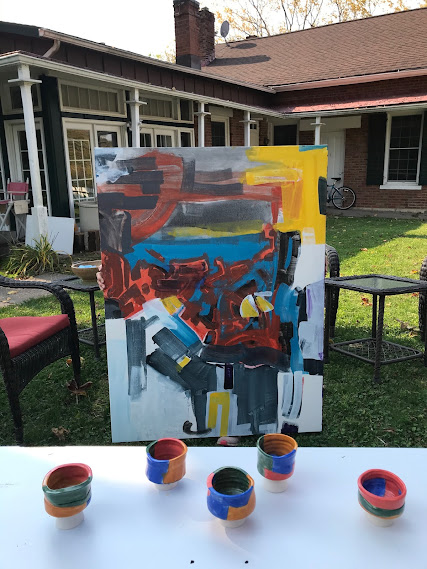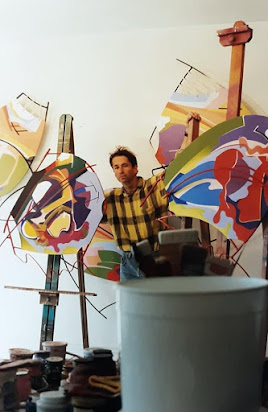Over the past year I have begun to study more closely my father's work. I have started to see themes, repeat images and changes to his style through the decades. I have also started to see how these commonalities relate to his life events. Perhaps, for me, this has been part of the grieving process.
The idea and focus on balance can be found in much of his work. Sometimes it is a quiet fulcrum within the painting, pastel, etching or drawing. Other times it is a smack in your face, as above, the whole image is about balance. His theme finds itself abstractly in the images he creates, but also physically in the shape of his iron pieces. These pieces often have one notch on the back of the painting, carved into the piece, so that it is suspended as he intended on your wall by one spot.
In his life, he was the only child. So he was the balance for his father and mother. Later in life he hit both immense joy and tragedy together. He found the woman he wanted to marry on the East Coast. The week before they were to join together in marriage, his father died of a heart attack while doing yard work. A week later he was marrying his bride, a most joyous occasion, while also balancing the utmost pain of losing a parent and caring for his grieving mother. He and his new bride moved in with his mother after their marriage to try and help her through the sadness. This moment in time should have been about new beginnings, love, pursuing his art with a free spirit, however, it was tumultuous. He had to care for his own grief, his mother's grief and all the while showing his new wife the excitement of the new, uncharted open path before them.
Several years passed and he chose to divorce his first wife and his two children, to better focus on his work. He quickly met his next bride to be. He fell in love, married and they quickly had a child. Again, a new beginning, but a balance with an existing life and children. The challenge of being with his new bride and their sweet baby while continuing to maintain the fatherly presence for his older children from his first marriage. He chose to be there for them as much as he could. Given the salary of a starting artist, travel was not easy, so deciding where he lived became part of the balance. He needed the market for his artwork, but also needed to be near to his children who were living in a small town in Illinois. Eventually, he found a balance in Pepin, Wisconsin. It was a small community, further away from his first family, then would be ideal, but also it had a market for fine arts and was near the Twin Cities.
Just after the birth of his fourth daughter his wife wanted to move back to Mineral Point, Wisconsin. The town which they had moved from years ago. While this town was not ideal for his art gallery and his market, he chose to make the move for the good of his family. He stopped working on his art, bought a new house in Mineral Point and started to build a studio in the woods. When he was finished building his studio, his wife shortly after requested a divorce. Balance was off for him. At that point, he had not been able to create any new artwork for over a year and therefore, lost some connections for his artwork sales..... and now lost his second family.
Several years later, he was diagnosed with Parkinson's disease. This was a crushing blow for him. He no longer could work in the iron frames given his inability to stay still for the demanding welding work and the precise work of sewing the canvas. His body was not in balance - his children and family life were out of balance too. It was a challenging time for his work and his emotion. As the disease progressed he stopped work all together - no art. Just controlling his own physical balance. He got encouragement from his daughters to continue, they bought him pre-stretched canvas and paint "markers". He started again. His life started to come into a balance once more emotionally. As his confidence grew in his new abilities to paint again, he moved away from the "markers" and back to brushes and larger canvases. His heart and soul craved the artwork. As the disease progressed his windows to paint waned, but he continued to create work until his last week of life.
I personally sensed balance was a driving force behind his lifelong pursuit in the arts. You will see his work move through periods and changes, but constant is the element of balance.




Comments
Post a Comment